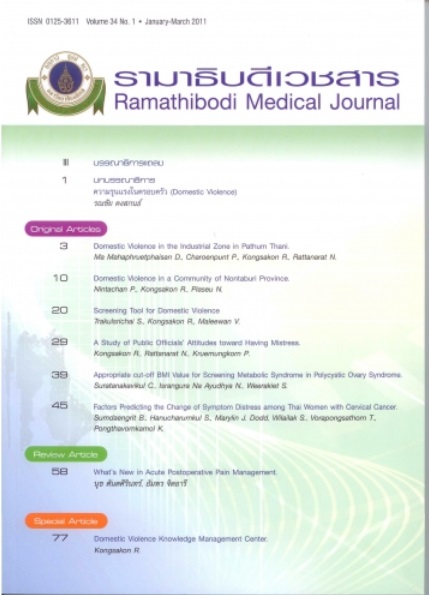Domestic Violence in a Community of Nontaburi Province
Keywords:
Domestic violence, Community, AttitudeAbstract
Objectives: To explore the size of the problem of Domestic Violence in a community of Nontaburi province.
Methods: This descriptive research included the sample of 378 from four villages in Nontaburi province.
Results: The results revealed that 7.8% of the sample experienced domestic violence including physical, psychological and/or financial-social abuse. The physical abuse with greater than or equal to 1 time per month consisted of beating/ punching (4.3%), throwing an object with anger (4.0%), and slapping (3.1%). The psychological abuse with greater than or equal to 1 time per month included partner’s extreme and unreasonable emotional expression (6.5%), and extreme verbal threats (5.3%). While the financial-social abuse with greater than or equal to 1 time per month included being followed by partners (10.2%), partners’ control of expense (5.0%), and paying a loan for their partners (3.7%).
Conclusion: Domestic Violence in a community of Nontaburi province was found at 7.8% including financial-social, physical, and psychological abuse. According to responses from the sample with positive attitude regarding a solution, the results suggested that associated organizations should use law enforcement to systematically solve this problem.
References
Archavanitkul K, Kanchanachitra C, Im-Em V, Lerdsrisantad, U. Domestic Violence and Woman's Health. Nakhon Pathom: Institute for Population and Social Research, Mahidol University; 2003.
Sripichyakan K. Termination of Family and Social Violence. Chiang Mai: Faculty of Nursing, Chiang Mai University; 2003. Available from: https://www.nurse.cmu.ac.th/stop-d/history.php.
Kongsakon R, Pocham N. Domestic Violence. Bangkok: Sahaprchapanich; 2008.
Kathleen Malley-Morrison K, Hines DA. Family Violence in a Cultural Perspective: Defining, Understanding, and Combating Abuse. Thousand Oaks, Calif: Sage Publications; 2004.
García-Moreno C, Jansen HAFM, Ellsberg M, Heise L, Watts C. WHO Multi-country Study on Women's Health and Domestic Violence against Women: Initial Results on Prevalence, Health Outcomes and Women's Responses. Geneva, Switzerland: World Health Organization; 2005. Available from: https://apps.who.int/iris/bitstream/handle/10665/43309/924159358X_eng.pdf?sequence=1&isAllowed=y.
Humphreys J, Campbell JC. Family Violence and Nursing Practice. Philadelphia, PA: Lippencott; 2004.
Kisekka MN. Addressing gender-based violence in East and South-East Asia. Bangkok, Thailand: UNFPA; 2007.
Srisorrachatr, S. Domestic Violence: Socio-Culture Perspective and Social Intervention in a Thai Community [master’s thesis]. Bangkok: Mahidol University; 2001.
Zinn MB, Eitzen DS. Violence in Families. In: Zinn MB, Eitzen DS, eds. Diversity in Families. 7th ed. Boston, MA: Allyn & Bacon; 2005. Available from: https://www.pearsonhighered.com/assets/samplechapter/0/2/0/5/0205406173.pdf.
Choocherd P. The Psychological Impact and Help Needed of Sexual Assault on Women: A Case Study at Siriraj Hospital [master’s thesis]. Bangkok: Thammasat University; 2000.
Bureau of Policy and Strategy, Ministry of Public Health. Development of policy briefing packages on critical and emerging health problems in Thailand. Bangkok: ETO Printin; 2005.
Chamberlain L. A Prevention Primer for Domestic Violence: Terminology, Tools, and the Public Health Approach. Harrisburg, PA: Vawnet, National Resource Center on Domestic Violence; 2008. Available from: https://vawnet.org/material/prevention-primer-domestic-violence-terminology-tools-and-public-health-approach.
Miller JL, Knudsen DD. Family Abuse and Violence. In: Sussman MB, Steinmetz SK, Peterson GW, eds. Handbook of Marriage and the Family. 2nd ed. New York, NY: Springer; 1999. doi:10.1007/978-1-4757-5367-7.
Aekplakorn W, Kongsakon R. Intimate partner violence among women in slum communities in Bangkok, Thailand. Singapore Med J. 2007;48(8):763-8.
Pan A, Daley S, Rivera LM, Williams K, Lingle D, Reznik V. Understanding the role of culture in domestic violence: the Ahimsa Project for Safe Families. J Immigr Minor Health. 2006;8(1):35-43. doi:10.1007/s10903-006-6340-y.
Cohen L, Chávez V, Chehimi S. Prevention is primary: strategies for community well-being. San Francisco, CA, Jossey-Bass; 2007.
Bank of Thailand. Thailand's Economic and Monetary Conditions in 2009. Bangkok: Monetary Policy Group; 2010. Available from: https://www.bot.or.th/Thai/MonetaryPolicy/EconomicConditions/AnnualReport/AnnualReport/annual_52.pdf.
United Nations. World Economic Situation and Prospects. New York: United Nations; 2010. Available from: https://www.un.org/en/development/desa/policy/wesp/wesp_archive/2010wesp.pdf.













